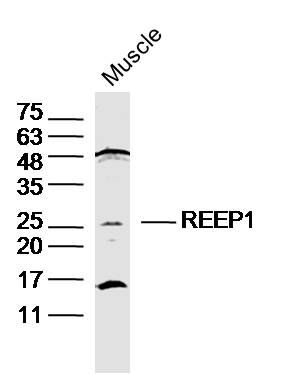产品货号 : mlR11752
英文名称 : REEP1
中文名称 : 受体辅助蛋白1抗体
别 名 : C2orf23; Chromosome 2 open reading frame 23; FLJ13110; Receptor accessory protein 1; Receptor expression-enhancing protein 1; Reep1; REEP1_HUMAN; SPG31.
研究领域 : 细胞生物 神经生物学 细胞膜受体 G蛋白偶联受体
抗体来源 : Rabbit
克隆类型 : Polyclonal
交叉反应 : Human, Mouse, Rat, Chicken, Dog, Pig, Cow, Horse, Rabbit, Sheep,
产品应用 : WB=1:500-2000 ELISA=1:500-1000 IHC-P=1:400-800 IHC-F=1:400-800 ICC=1:100-500 IF=1:100-500 (石蜡切片需做抗原修复)
not yet tested in other applications.
optimal dilutions/concentrations should be determined by the end user.
分 子 量 : 22kDa
细胞定位 : 细胞浆 细胞膜
性 状 : Lyophilized or Liquid
浓 度 : 1mg/ml
免 疫 原 : KLH conjugated synthetic peptide derived from human REEP1:53-150/201
亚 型 : IgG
纯化方法 : affinity purified by Protein A
储 存 液 : 0.01M TBS(pH7.4) with 1% BSA, 0.03% Proclin300 and 50% Glycerol.
保存条件 : Store at -20 °C for one year. Avoid repeated freeze/thaw cycles. The lyophilized antibody is stable at room temperature for at least one month and for greater than a year when kept at -20°C. When reconstituted in sterile pH 7.4 0.01M PBS or diluent of antibody the antibody is stable for at least two weeks at 2-4 °C.
PubMed : PubMed
产品介绍 : Transport of G protein-coupled receptors (GPCRs) to the cell surface membrane is critical for receptor-ligand recognition. Mammalian GPCR odorant receptors (ORs), when heterologously expressed in cells, are poorly expressed on the cell surface. REEP1 (receptor expression-enhancing protein 1), is a 201 amino acid multi-pass mitochondrion membrane protein that belongs to the DP1 family. REEP1 interacts with odorant receptor proteins and may enhance the cell surface expression of odorant receptors. Mutations in the REEP1 gene are the third most common cause of hereditary spastic paraplegia (HSP) after spastin and atlastin gene mutations. Mutations in the REEP1 gene also cause spastic paraplegia autosomal dominant type 31, a neurodegenerative disorder. The REEP1 gene is conserved in chimpanzee, dog, cow, mouse, rat, chicken, zebrafish, A.thaliana and rice, and maps to human chromosome 2p11.2.
Function:
May enhance the cell surface expression of odorant receptors.
Subunit:
Interacts with SPAST and ATL1; it preferentiallyinteracts with SPAST isoform 1. Interacts (via C-terminus) withmicrotubules. Interacts with odorant receptor proteins
Subcellular Location:
Membrane. Mitochondrion membrane; Multi-passmembrane protein. Endoplasmic reticulum.
Post-translational modifications:
Belongs to the DP1 family.
DISEASE:
Defects in REEP1 are the cause of spastic paraplegia autosomal dominant type 31 (SPG31) [MIM:610250]. Spastic paraplegia is a neurodegenerative disorder characterized by a slow, gradual, progressive weakness and spasticity of the lower limbs. Rate of progression and the severity of symptoms are quite variable. Initial symptoms may include difficulty with balance, weakness and stiffness in the legs, muscle spasms, and dragging the toes when walking. In some forms of the disorder, bladder symptoms (such as incontinence) may appear, or the weakness and stiffness may spread to other parts of the body.
Similarity:
Belongs to the DP1 family.
SWISS:
Q9H902
Gene ID:
65055
Important Note:
This product as supplied is intended for research use only, not for use in human, therapeutic or diagnostic applications.
产品图片












